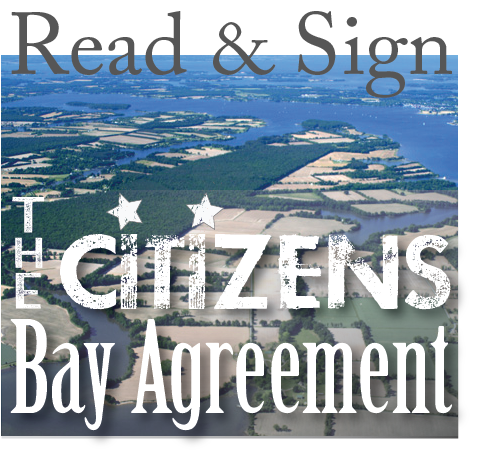Chesapeake Bay Action Plan
After decades of effort, the voluntary, collaborative approach to restoring the health and vitality of the Chesapeake Bay— the largest estuary in the United States—has not worked and, in fact, is failing.
A diverse group of 57 senior scientists and policymakers have joined forces to save the Bay. This is our plan.
The Power Gap
(Posted by Fred Tutman)
Who really has the power to clean up the Bay? Are our messages of watershed improvement directed at anybody in particular, or everybody in general? Who really controls that vague and nebulous political willpower that we keep hearing so much about? When I try to envision a truly effective movement to save the region’s waterways, I generally try to get a mental picture of what that sort of power establishment would look like. Is it an army of crunchy people wearing fleece and driving hybrid cars? Or is it “rainbow coalition” of rank and file marching abreast determined to march on until we all achieve the promises and the right of clean water? Laugh out loud! Whichever scenario you choose, there is a real gap between our aspirations and the strategies we are using to get there.
Why We Lose
(Posted by Howard Ernst)
Maryland Political Contributions (2010)
MD. House of Delegates: 20,419,460.34
MD. State Senate: $11,529,149.72
MD. Governor: $ 18,777,841.15
Doctor for the Bay
(Posted by Walter Boynton)
I’m a general ecologist and I’m primarily interested in estuaries. In a sense this is equivalent to being a general practitioner in the medical field…the local doc sees lots of different illnesses and so do general ecologists. I’ve been involved in studies of fish recruitment, seagrass ecology, power plant impacts on estuaries and nutrient effects on estuarine water quality and others that don’t readily come to mind. All have been interesting, some have been really baffling and still others have been largely solved. Trying to understand how nature works is basically what we do.
Polluters and Their Allies Attack Chesapeake Pollution Diet
(Posted by Gerald Winegrad)
Despite repeated written commitments and solemn pledges made over the last 27 years, the states in the Bay watershed have failed by wide margins to reduce the nutrient, sediment, and chemical pollutants poisoning the Chesapeake Bay. The voluntary-collaborative Chesapeake Bay Program has failed to restore the Bay’s waters from being so polluted that 90 percent of the water does not meet basic Clean Water Act standards.
Some Inconvenient Truths About Restoring the Bay
(Posted by Gerald Winegrad)
Please join me, Friday, Nov. 19, 3:00 p.m. in Room 1140 of the Plant Sciences Building at the University of Maryland, College Park for a presentation on the status of Chesapeake Bay restoration and what needs to be done. The states have repeatedly failed to meet agreed upon pollution reductions and the EPA has set a pollution diet (TMDL) that requires states to reduce pollutants or face federal sanctions for the first time. Efforts to achieve Bay restoration are still lagging as 90 percent of the Bay’s waters fail to meet Clean Water Act requirements and therefore, the states are in violation of the Clean Water Act.
Do We Need Any More Science to Restore Chesapeake Bay?
(Posted by Bill Dennison)
Chesapeake Bay is arguably the best studied estuary in the world, with a long history of scientific research culminating in theses, scientific journal articles, scientific society activities including workshops and conferences. Many of the paradigms on how estuaries work have been developed through studies of Chesapeake Bay. This leads to the question posed in the title, “Do we need any more science to restore Chesapeake Bay?”. Many people have said to me that we know enough already and we don’t need more science, we just need to get on with the restoration. These comments are in part a result of the frustration that we have not more made more progress in Chesapeake restoration. Research can, in fact, be used as a delaying tactic if restoration activities are forced to wait for more data. Researchers can be complicit in the criticism if they allow the perfect to be the enemy of the good or if they simply document the decline and focus solely on the problems, rather than the solutions.
The Fog of the Bay
(Posted by Fred Tutman) As this is my first post on a new blog, I feel I should explain who I am and why I think my perspective brings something different to the table. A child of my waterway (the Patuxent). I grew up with a deep love and a soulful connection to nature of…
Science and the Chesapeake Bay Action Plan
(Posted by Howard Ernst)
For decades, discussions about Chesapeake Bay policy have been dominated by the hundreds of environmental organizations that claim to represent the Bay and the hundreds of industry leaders that the environmentalists often oppose. The industry leaders are typically depicted by their environmental opponents as profiting from using the Bay as a cheap and convenient place to dispose of unwanted byproducts (poultry waste, toxic waste from steel production, runoff from developers…). The environmentalists, on the other hand, are viewed by their industrial opponents as championing pie in the sky ideas that are too expensive and too impractical to be taken seriously.
We are senior Chesapeake Bay scientists and policymakers from Maryland, Virginia and Pennsylvania who have concluded that after decades of effort, the voluntary, collaborative approach to restoring the health and vitality of the largest estuary in the United States has not worked and, in fact, is failing. Our group unanimously recommends that all states draining into the Chesapeake Bay adopt our 25 action items in their Watershed Implementation Plans (WIP) and implement them to improve the Bay’s water quality and to meet the requirements of the Clean Water Act.
Sign up for news & updates from Patuxent Riverkeeper
